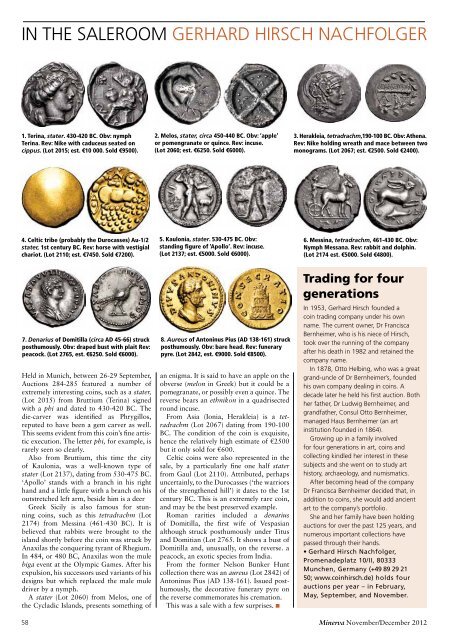Following Odysseus Not the end of the world Amarna city of light ...
Following Odysseus Not the end of the world Amarna city of light ...
Following Odysseus Not the end of the world Amarna city of light ...
- No tags were found...
Create successful ePaper yourself
Turn your PDF publications into a flip-book with our unique Google optimized e-Paper software.
In <strong>the</strong> saleroom GERHARD HIRSCH NACHFOLGER1. Terina, stater. 430-420 BC. Obv: nymphTerina. Rev: Nike with caduceus seated oncippus. (Lot 2015; est. €10 000. Sold €9500).2. Melos, stater, circa 450-440 BC. Obv: ‘apple’or pomengranate or quince. Rev: incuse.(Lot 2060; est. €6250. Sold €6000).3. Herakleia, tetradrachm,190-100 BC. Obv: A<strong>the</strong>na.Rev: Nike holding wreath and mace between twomonograms. (Lot 2067; est. €2500. Sold €2400).4. Celtic tribe (probably <strong>the</strong> Durocasses) Au-1/2stater, 1st century BC. Rev: horse with vestigialchariot. (Lot 2110; est. €7450. Sold €7200).5. Kaulonia, stater. 530-475 BC. Obv:standing figure <strong>of</strong> ‘Apollo’. Rev: incuse.(Lot 2137; est. €5000. Sold €6000).6. Messina, tetradrachm, 461-430 BC. Obv:Nymph Messana. Rev: rabbit and dolphin.(Lot 2174 est. €5000. Sold €4800).7. Denarius <strong>of</strong> Domitilla (circa AD 45-66) struckposthumously. Obv: draped bust with plait Rev:peacock. (Lot 2765, est. €6250. Sold €6000).Held in Munich, between 26-29 September,Auctions 284-285 featured a number <strong>of</strong>extremely interesting coins, such as a stater,(Lot 2015) from Bruttium (Terina) signedwith a phi and dated to 430-420 BC. Thedie-carver was identified as Phrygillos,reputed to have been a gem carver as well.This seems evident from this coin’s fine artisticexecution. The letter phi, for example, israrely seen so clearly.Also from Bruttium, this time <strong>the</strong> <strong>city</strong><strong>of</strong> Kaulonia, was a well-known type <strong>of</strong>stater (Lot 2137), dating from 530-475 BC.‘Apollo’ stands with a branch in his righthand and a little figure with a branch on hisoutstretched left arm, beside him is a deerGreek Sicily is also famous for stunningcoins, such as this tetradrachm (Lot2174) from Messina (461-430 BC). It isbelieved that rabbits were brought to <strong>the</strong>island shortly before <strong>the</strong> coin was struck byAnaxilas <strong>the</strong> conquering tyrant <strong>of</strong> Rhegium.In 484, or 480 BC, Anaxilas won <strong>the</strong> mulebiga event at <strong>the</strong> Olympic Games. After hisexpulsion, his successors used variants <strong>of</strong> hisdesigns but which replaced <strong>the</strong> male muledriver by a nymph.A stater (Lot 2060) from Melos, one <strong>of</strong><strong>the</strong> Cycladic Islands, presents something <strong>of</strong>8. Aureus <strong>of</strong> Antoninus Pius (AD 138-161) struckposthumously. Obv: bare head. Rev: funerarypyre. (Lot 2842, est. €9000. Sold €8500).an enigma. It is said to have an apple on <strong>the</strong>obverse (melon in Greek) but it could be apomegranate, or possibly even a quince. Thereverse bears an ethnikon in a quadrisectedround incuse.From Asia (Ionia, Herakleia) is a tetradrachm(Lot 2067) dating from 190-100BC. The condition <strong>of</strong> <strong>the</strong> coin is exquisite,hence <strong>the</strong> relatively high estimate <strong>of</strong> €2500but it only sold for €600.Celtic coins were also represented in <strong>the</strong>sale, by a particularly fine one half staterfrom Gaul (Lot 2110). Attributed, perhapsuncertainly, to <strong>the</strong> Durocasses (‘<strong>the</strong> warriors<strong>of</strong> <strong>the</strong> streng<strong>the</strong>ned hill’) it dates to <strong>the</strong> 1stcentury BC. This is an extremely rare coin,and may be <strong>the</strong> best preserved example.Roman rarities included a denarius<strong>of</strong> Domitilla, <strong>the</strong> first wife <strong>of</strong> Vespasianalthough struck posthumously under Titusand Domitian (Lot 2765. It shows a bust <strong>of</strong>Domitilla and, unusually, on <strong>the</strong> reverse. apeacock, an exotic species from India.From <strong>the</strong> former Nelson Bunker Huntcollection <strong>the</strong>re was an aureus (Lot 2842) <strong>of</strong>Antoninus Pius (AD 138-161). Issued posthumously,<strong>the</strong> decorative funerary pyre on<strong>the</strong> reverse commemorates his cremation.This was a sale with a few surprises. nTrading for fourgenerationsIn 1953, Gerhard Hirsch founded acoin trading company under his ownname. The current owner, Dr FranciscaBernheimer, who is his niece <strong>of</strong> Hirsch,took over <strong>the</strong> running <strong>of</strong> <strong>the</strong> companyafter his death in 1982 and retained <strong>the</strong>company name.In 1878, Otto Helbing, who was a greatgrand-uncle <strong>of</strong> Dr Bernheimer’s, foundedhis own company dealing in coins. Adecade later he held his first auction. Bothher fa<strong>the</strong>r, Dr Ludwig Bernheimer, andgrandfa<strong>the</strong>r, Consul Otto Bernheimer,managed Haus Bernheimer (an artinstitution founded in 1864).Growing up in a family involvedfor four generations in art, coins andcollecting kindled her interest in <strong>the</strong>sesubjects and she went on to study arthistory, archaeology, and numismatics.After becoming head <strong>of</strong> <strong>the</strong> companyDr Francisca Bernheimer decided that, inaddition to coins, she would add ancientart to <strong>the</strong> company’s portfolio.She and her family have been holdingauctions for over <strong>the</strong> past 125 years, andnumerous important collections havepassed through <strong>the</strong>ir hands.• Gerhard Hirsch Nachfolger,Promenadeplatz 10/II, 80333Munchen, Germany (+49 89 29 2150; www.coinhirsch.de) holds fourauctions per year – in February,May, September, and November.58 Minerva November/December 2012
















